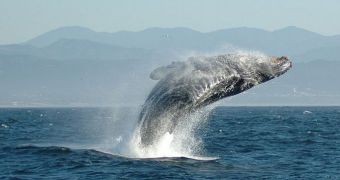Everybody knows that whales communicate using very high-pitched sounds that resemble clicks. These sounds can be heard over incredibly long distances, and prove that the creatures are intelligent and able to understand each other. But this discovery, for example, was only made possible through the use of acoustic surveillance tools, such as real-time and archival sensors. Experts have been traveling the world's oceans via ships, keeping close tabs on endangered species populations and on activities that may be disrupting the environment. But their work is also disruptive, e! Science News reports.
One of the main reasons why whales change the sounds they produce is the shifting background noise. This is the natural sound of the ocean, produced by waves, wind, and all the creatures inside. Human activities, such as traveling ships and sonars currently in use, alter it, forcing the mammals that employ sounds to communicate to change the frequency on which they emit these sounds. Scientists are unsure at this point as to the long-term effects that these changes will have on the whale population, for example, but plan to develop measures that would reverse these abnormalities.
The tools used to survey whales and dolphins have improved considerably over the past ten years, experts say. In addition to helping researchers gain new insight into the daily lives of these majestic creatures, the new data sets also helped experts develop policies that reduced the number of ship strikes, which are the main cause of whale death in the North Atlantic Ocean. The new sensors also proved their worth in international management and conservation projects aimed at the seas.
“The tools available to acquire and analyze passive acoustic data have undergone a revolutionary change over the last ten years, and have substantially increased our ability to collect acoustic information and use it as a functional management tool. These tools have significantly improved monitoring of North Atlantic right whales and enhanced the efficacy of managing ship traffic to reduce ship strikes of whales through much of the western North Atlantic off the US East Coast,” the lead author of a new study, Sofie Van Parijs, explains. She is an expert at the Northeast Fisheries Science Center laboratory, an institute of the US National Oceanic and Atmospheric Administration (NOAA).
“Marine animals live their lives and communicate acoustically across different time and space scales and use sound for different reasons. We need to use the right tool in the right place for the right need. There is no 'one size fits all' when it comes to using technology in the ocean,” she concludes.

 14 DAY TRIAL //
14 DAY TRIAL //